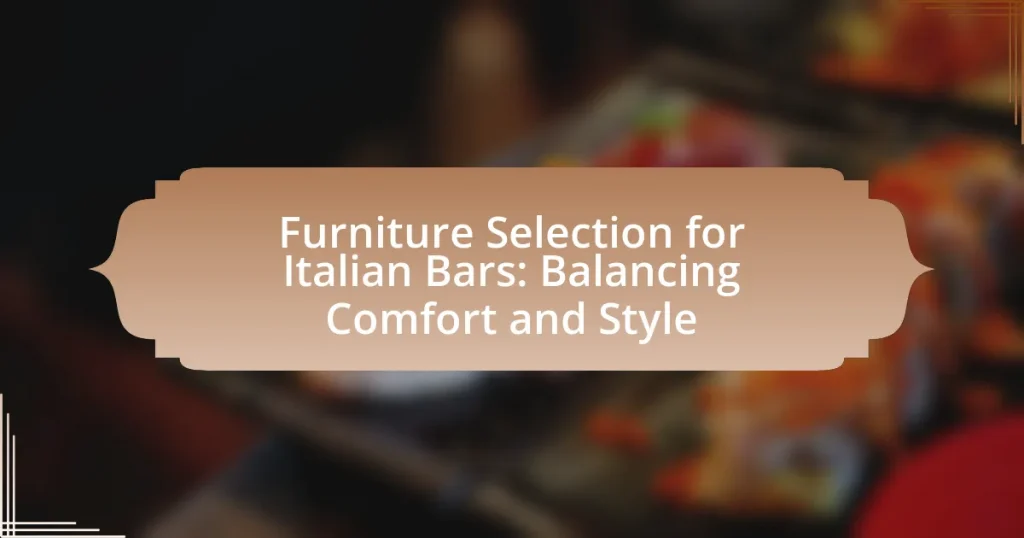The article focuses on the critical role of furniture selection in Italian bars, emphasizing the balance between comfort and style to enhance customer experience and brand identity. It outlines how well-chosen furniture impacts ambiance, social interaction, and customer satisfaction, highlighting key factors such as material durability, functionality, and aesthetic appeal. The discussion includes various furniture types commonly used, the importance of layout and space considerations, and the influence of decorative elements and lighting on overall design. Additionally, it addresses best practices for sourcing furniture, assessing customer preferences, and adapting to seasonal changes, providing practical tips for creating an inviting and cohesive bar environment.

What is the importance of furniture selection for Italian bars?
The importance of furniture selection for Italian bars lies in its impact on customer experience and ambiance. Well-chosen furniture enhances comfort, encouraging patrons to linger and enjoy their time, which can lead to increased sales. Additionally, the aesthetic appeal of the furniture reflects the bar’s identity and cultural heritage, creating a welcoming atmosphere that attracts customers. For instance, traditional Italian bars often feature rustic wooden tables and comfortable seating that evoke a sense of authenticity, aligning with the cultural expectations of patrons. This strategic selection not only influences customer satisfaction but also plays a crucial role in brand differentiation in a competitive market.
How does furniture impact the overall ambiance of an Italian bar?
Furniture significantly impacts the overall ambiance of an Italian bar by influencing comfort, aesthetics, and social interaction. The choice of materials, colors, and styles can evoke a sense of warmth and tradition, essential for creating an inviting atmosphere typical of Italian culture. For instance, wooden tables and chairs can provide a rustic charm, while vibrant upholstery can enhance the lively spirit of the space. Research indicates that comfortable seating arrangements encourage longer visits, which is crucial for socializing in bars. Additionally, the layout of furniture affects flow and accessibility, contributing to a welcoming environment that fosters community engagement.
What role does comfort play in customer satisfaction?
Comfort is a critical factor in customer satisfaction, as it directly influences the overall experience of patrons in establishments like Italian bars. When customers feel comfortable, they are more likely to enjoy their time, leading to longer visits and increased likelihood of return. Research indicates that 70% of customers cite comfort as a key reason for their satisfaction in dining environments, highlighting its importance in furniture selection. Therefore, prioritizing comfort in furniture design not only enhances customer satisfaction but also contributes to the establishment’s success and reputation.
How does style influence the perception of the bar’s brand?
Style significantly influences the perception of a bar’s brand by shaping customer expectations and experiences. A well-defined style, such as modern, rustic, or elegant, communicates the bar’s identity and target audience, impacting customer attraction and retention. For instance, a bar with a chic, contemporary design may attract a younger, trend-focused clientele, while a traditional, cozy atmosphere might appeal to families or older patrons. Research indicates that 60% of consumers make decisions based on the ambiance and style of a venue, highlighting the importance of aesthetic choices in brand perception. Thus, the alignment of furniture selection and overall design with the desired brand image is crucial for establishing a strong market presence.
What are the key factors to consider when selecting furniture?
The key factors to consider when selecting furniture for Italian bars include comfort, style, durability, and functionality. Comfort is essential as patrons will spend extended periods seated, influencing their overall experience. Style should reflect the bar’s theme and ambiance, with Italian aesthetics often favoring rustic or modern designs that create an inviting atmosphere. Durability is crucial due to high foot traffic; materials like hardwood or metal are preferable for longevity. Functionality involves ensuring the furniture arrangement facilitates movement and social interaction, optimizing the space for both patrons and staff. These factors collectively enhance customer satisfaction and operational efficiency in an Italian bar setting.
How do space and layout affect furniture choices?
Space and layout significantly influence furniture choices by determining the size, style, and arrangement of pieces to optimize functionality and aesthetics. In Italian bars, where social interaction is key, the layout must accommodate both seating capacity and comfort, leading to selections that prioritize compact designs for high-density areas while ensuring ease of movement. For instance, a study by the Journal of Interior Design highlights that effective space utilization can enhance customer experience, indicating that furniture must align with the spatial dimensions to create an inviting atmosphere. Thus, the interplay between space and layout directly impacts the selection of furniture that balances comfort and style in Italian bars.
What materials are best suited for Italian bar furniture?
Wood, metal, and leather are the best materials suited for Italian bar furniture. Wood provides warmth and elegance, often seen in traditional Italian designs, while metal offers durability and a modern aesthetic, frequently used in contemporary settings. Leather enhances comfort and sophistication, making it a popular choice for seating. These materials collectively reflect the Italian emphasis on style and functionality, ensuring that the furniture not only looks appealing but also withstands the rigors of bar environments.
Why is it essential to balance comfort and style in furniture selection?
Balancing comfort and style in furniture selection is essential because it directly impacts customer satisfaction and the overall ambiance of the space. Comfortable furniture encourages patrons to stay longer, which can lead to increased sales, while stylish furniture enhances the aesthetic appeal and brand identity of the establishment. Research indicates that 70% of customers are more likely to return to a venue that offers both comfort and visual appeal, demonstrating the importance of this balance in creating a successful environment.
What are the consequences of prioritizing one over the other?
Prioritizing comfort over style in furniture selection for Italian bars can lead to a welcoming atmosphere that encourages longer customer stays, ultimately increasing sales. Conversely, prioritizing style over comfort may create an aesthetically pleasing environment but can result in customer discomfort, leading to shorter visits and potential loss of repeat business. Research indicates that establishments with comfortable seating see a 20% increase in customer retention, demonstrating the tangible impact of comfort on business performance.
How can a balance enhance customer experience and retention?
A balance between comfort and style in furniture selection enhances customer experience and retention by creating an inviting atmosphere that encourages longer visits. Comfortable seating allows patrons to relax and enjoy their time, while stylish design elements attract customers and reinforce brand identity. Research indicates that establishments with well-balanced environments see a 20% increase in customer satisfaction, leading to higher retention rates. This correlation demonstrates that when customers feel both comfortable and aesthetically pleased, they are more likely to return and recommend the venue to others.

What types of furniture are commonly used in Italian bars?
Italian bars commonly use a variety of furniture types, including high tables, bar stools, and comfortable lounge seating. High tables facilitate social interaction and are often paired with bar stools, which are designed for easy access and mobility. Additionally, lounge seating, such as sofas and armchairs, provides a relaxed atmosphere for patrons. The combination of these furniture types enhances both comfort and style, reflecting the Italian culture of socializing over food and drinks.
What are the different seating options available?
The different seating options available for Italian bars include bar stools, lounge chairs, dining chairs, and benches. Bar stools are typically tall and designed for counter-height tables, providing a casual atmosphere. Lounge chairs offer comfort and style, often used in relaxed seating areas. Dining chairs are standard height and suitable for traditional dining setups, while benches can accommodate larger groups and promote a communal feel. Each option contributes to the overall ambiance and functionality of the bar, catering to diverse customer preferences and enhancing the social experience.
How do chairs and stools differ in functionality and style?
Chairs and stools differ primarily in height, design, and intended use. Chairs typically have a backrest and armrests, providing greater comfort for prolonged seating, making them suitable for dining and relaxation. In contrast, stools are generally higher, lack backrests, and are designed for quick seating, often used at bars or counters. This functional distinction is reflected in their styles; chairs often feature more elaborate designs and upholstery, while stools tend to have a minimalist aesthetic, focusing on practicality and space efficiency. For example, bar stools are designed to fit under counters, optimizing space in busy environments like Italian bars, where quick service is essential.
What are the benefits of using booths versus traditional seating?
Booths offer several benefits over traditional seating, primarily in terms of comfort, privacy, and space efficiency. The design of booths provides a more intimate dining experience, allowing patrons to enjoy meals without the distractions often present in open seating arrangements. Additionally, booths can maximize space utilization in restaurants, accommodating more guests in a smaller footprint compared to traditional tables and chairs. Research indicates that establishments utilizing booths often report higher customer satisfaction and increased return visits, as the enclosed nature of booths can enhance the overall dining experience.
What tables are ideal for Italian bar settings?
Ideal tables for Italian bar settings are typically small, round or square, and made of wood or metal. These tables facilitate intimate gatherings and encourage social interaction, which is essential in Italian culture. The use of materials like wrought iron or reclaimed wood not only enhances aesthetic appeal but also aligns with traditional Italian design principles. Additionally, tables with a height suitable for both standing and seated patrons promote versatility, accommodating various customer preferences and enhancing the overall bar experience.
How do table sizes and shapes affect social interaction?
Table sizes and shapes significantly influence social interaction by determining the level of intimacy and engagement among individuals. Larger tables, such as rectangular or oval shapes, facilitate group conversations and allow for more participants, promoting a sense of community. In contrast, smaller, round tables create a more intimate setting, encouraging closer interactions and personal conversations. Research indicates that the physical arrangement of tables can affect communication dynamics; for instance, a study published in the Journal of Environmental Psychology found that round tables foster collaboration and equality among participants, while rectangular tables can create hierarchical structures. Thus, the choice of table size and shape directly impacts the nature of social interactions in settings like Italian bars, where comfort and style are essential for enhancing customer experience.
What materials are recommended for durability and aesthetics?
Wood, metal, and high-quality upholstery are recommended materials for durability and aesthetics in furniture selection for Italian bars. Wood, particularly hardwoods like oak and walnut, offers strength and a classic look, while metal, such as stainless steel or powder-coated finishes, provides a modern touch and resistance to wear. High-quality upholstery materials, like leather or durable synthetic fabrics, enhance comfort and visual appeal, ensuring that the furniture withstands heavy use while maintaining an attractive appearance. These materials are commonly chosen for their ability to combine functionality with style, making them ideal for the vibrant atmosphere of Italian bars.
What decorative elements complement furniture in Italian bars?
Decorative elements that complement furniture in Italian bars include ornate mirrors, vintage lighting fixtures, and traditional artwork. These elements enhance the overall aesthetic by reflecting Italian culture and style, creating an inviting atmosphere. For instance, ornate mirrors not only add depth but also amplify light, while vintage lighting fixtures, such as chandeliers or pendant lights, provide a warm glow that complements wooden or metal furniture. Traditional artwork, often depicting Italian landscapes or historical scenes, adds character and connects the space to its cultural roots, making the environment more engaging for patrons.
How can lighting enhance the furniture’s appeal?
Lighting can significantly enhance furniture’s appeal by highlighting its design features and creating an inviting atmosphere. Proper lighting draws attention to the textures, colors, and shapes of furniture, making them more visually appealing. For instance, warm lighting can soften the appearance of wood finishes, while accent lighting can emphasize unique design elements, such as intricate carvings or upholstery patterns. Studies show that well-lit spaces can increase customer satisfaction and encourage longer stays in hospitality settings, such as Italian bars, where ambiance is crucial for comfort and style.
What role do accessories play in creating a cohesive look?
Accessories play a crucial role in creating a cohesive look by enhancing the overall aesthetic and tying together various elements of design. In the context of Italian bars, accessories such as lighting fixtures, artwork, and decorative items complement the furniture selection, ensuring that each piece works harmoniously with the others. For instance, a well-chosen pendant light can accentuate the style of bar stools and tables, while artwork reflecting Italian culture can unify the theme. This integration of accessories not only reinforces the intended atmosphere but also contributes to a memorable customer experience, as evidenced by studies showing that cohesive design elements can increase customer satisfaction and retention in hospitality settings.

How can one effectively implement furniture selection strategies?
To effectively implement furniture selection strategies for Italian bars, one should prioritize a balance between comfort and aesthetic appeal. This involves assessing the target demographic and the bar’s theme to choose furniture that enhances the overall atmosphere while ensuring customer comfort. For instance, selecting ergonomic seating options can improve patron satisfaction, as studies show that comfortable seating increases the duration of customer visits, thereby boosting sales. Additionally, incorporating materials and designs that reflect Italian culture, such as rustic wood or vibrant colors, can create an inviting ambiance that attracts customers.
What steps should be taken to assess customer needs and preferences?
To assess customer needs and preferences, conduct surveys and interviews to gather direct feedback from patrons. This method allows for the collection of specific insights regarding their comfort, style preferences, and overall experience in the bar setting. Additionally, analyze customer behavior through observation and sales data to identify trends in furniture choices and usage patterns. Research indicates that 70% of businesses that actively seek customer feedback see improved customer satisfaction and loyalty, reinforcing the importance of understanding customer needs in the context of furniture selection for Italian bars.
How can surveys and feedback inform furniture choices?
Surveys and feedback can significantly inform furniture choices by providing direct insights into customer preferences and experiences. By collecting data on aspects such as comfort, style, and functionality, businesses can tailor their furniture selections to meet the specific needs of their clientele. For instance, a survey might reveal that patrons prefer softer seating options for longer stays, prompting a bar to invest in plush sofas instead of rigid chairs. Additionally, feedback can highlight trends in design preferences, allowing establishments to stay current and appealing. Research indicates that businesses that actively incorporate customer feedback into their decision-making processes see a 10-15% increase in customer satisfaction, which directly correlates with repeat visits and increased sales.
What trends should be considered in the selection process?
Current trends in the selection process for furniture in Italian bars emphasize sustainability, multifunctionality, and aesthetic appeal. Sustainable materials, such as reclaimed wood and eco-friendly fabrics, are increasingly preferred due to growing environmental awareness among consumers. Multifunctional furniture, which can serve multiple purposes, is favored to maximize space efficiency in often limited bar environments. Additionally, aesthetic appeal, particularly designs that reflect Italian culture and style, plays a crucial role in attracting customers and enhancing their experience. According to a 2022 report by the International Furniture Fair, 70% of consumers prioritize sustainability in their purchasing decisions, highlighting the importance of these trends in the selection process.
What are the best practices for sourcing furniture for Italian bars?
The best practices for sourcing furniture for Italian bars include selecting durable materials, ensuring comfort, and reflecting Italian aesthetics. Durable materials like hardwood or metal withstand high traffic and wear, essential for busy bar environments. Comfort is crucial, as patrons often spend extended periods seated; therefore, ergonomic designs should be prioritized. Additionally, incorporating elements of Italian design, such as sleek lines and vibrant colors, enhances the bar’s ambiance and aligns with cultural expectations. Research indicates that well-designed furniture can increase customer satisfaction and retention, making these practices vital for success in the hospitality industry.
How can one find reliable suppliers and manufacturers?
To find reliable suppliers and manufacturers, one should utilize industry-specific trade shows and online platforms that specialize in furniture sourcing. Trade shows like the Salone del Mobile in Milan provide direct access to reputable manufacturers and allow for face-to-face interactions, which can establish trust and credibility. Online platforms such as Alibaba and ThomasNet offer extensive directories of suppliers, complete with reviews and ratings that help assess reliability. According to a 2021 survey by Statista, 70% of businesses reported that attending trade shows significantly improved their supplier relationships, highlighting the effectiveness of this method.
What factors should be considered when budgeting for furniture?
When budgeting for furniture, key factors include material quality, design aesthetics, functionality, and durability. Material quality affects both the initial cost and long-term maintenance; for instance, solid wood typically costs more but lasts longer than particleboard. Design aesthetics should align with the bar’s theme, as appealing furniture can enhance customer experience and potentially increase sales. Functionality is crucial; furniture must accommodate the intended use, such as seating capacity and comfort for patrons. Durability is essential in high-traffic environments like bars, where furniture endures frequent use and potential wear and tear. These considerations ensure that the investment in furniture meets both financial and operational goals effectively.
What common mistakes should be avoided in furniture selection?
Common mistakes to avoid in furniture selection include neglecting space measurements, overlooking comfort, and failing to consider the overall theme. Neglecting space measurements can lead to overcrowding or underutilization, which disrupts the flow of the bar. Overlooking comfort can result in patrons feeling uncomfortable, leading to shorter visits and reduced customer satisfaction. Failing to consider the overall theme can create a disjointed atmosphere, detracting from the intended ambiance of an Italian bar. These mistakes can negatively impact customer experience and business success.
How can overestimating space lead to poor furniture choices?
Overestimating space can lead to poor furniture choices by causing individuals to select oversized or inappropriate pieces that do not fit the actual dimensions of the area. When people inaccurately assess the available space, they may choose furniture that overwhelms the environment, resulting in a cramped and uncomfortable atmosphere. For instance, a study by the American Society of Interior Designers indicates that improper scale and proportion in furniture selection can negatively impact the functionality and aesthetic appeal of a space. This misjudgment can ultimately detract from the intended comfort and style, particularly in settings like Italian bars where ambiance is crucial for customer experience.
What are the pitfalls of neglecting maintenance and durability?
Neglecting maintenance and durability in furniture selection for Italian bars leads to increased costs and decreased customer satisfaction. When furniture is not properly maintained, it deteriorates faster, resulting in the need for frequent replacements, which can significantly inflate operational expenses. Additionally, worn or damaged furniture can create an uninviting atmosphere, negatively impacting the overall customer experience and potentially leading to a decline in patronage. Studies show that establishments with well-maintained furniture report higher customer retention rates, emphasizing the importance of durability and upkeep in maintaining a successful bar environment.
What practical tips can enhance furniture selection for Italian bars?
To enhance furniture selection for Italian bars, prioritize comfort, style, and functionality. Comfortable seating encourages patrons to linger, which can increase sales; studies show that comfortable environments can boost customer satisfaction and retention. Choose materials that reflect Italian aesthetics, such as wood and leather, which are durable and easy to maintain. Additionally, consider the layout to facilitate smooth traffic flow and social interaction, as a well-planned space can enhance the overall experience. Finally, incorporate elements that reflect local culture and heritage, as this can create a unique ambiance that attracts customers.
How can one create a harmonious blend of comfort and style?
To create a harmonious blend of comfort and style in furniture selection for Italian bars, one should prioritize ergonomic design alongside aesthetic appeal. Ergonomic furniture, such as well-designed chairs and tables, enhances comfort by supporting the body properly, which is essential for patrons who may spend extended periods in the bar. Simultaneously, selecting materials and colors that reflect the Italian aesthetic—such as rich woods, soft textiles, and vibrant colors—contributes to the overall style. Research indicates that environments combining comfort with appealing design can increase customer satisfaction and dwell time, ultimately benefiting business performance.
What strategies can be employed to adapt furniture to seasonal changes?
To adapt furniture to seasonal changes, businesses can implement strategies such as using removable and washable covers, selecting weather-resistant materials, and incorporating modular designs. Removable covers allow for easy cleaning and seasonal updates, while weather-resistant materials like treated wood or synthetic fibers ensure durability against varying climates. Modular designs enable flexibility in arrangement, accommodating different seasonal layouts or events. These strategies enhance both the aesthetic appeal and functionality of furniture in Italian bars, ensuring comfort and style throughout the year.










